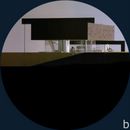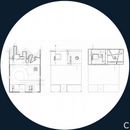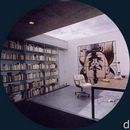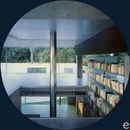





A wealthy married couple with three children lived in a very old and beautiful house in Bordeaux in France. For many years this family was thinking about building a new home, planning how it could be and wondering who the architect would be. Suddenly, the husband had a car accident and almost lost his life. Now he needs a wheelchair. The old beautiful house and the medieval city of Bordeaux had now become a prison for him. The family started to think about their new house again but this time in a very different way.
Circulation in the new house.
The married couple bought a hill with a panoramic view over the city and approached the Dutch architect Rem Koolhaas in 1994. The husband explained to him: "Contrary to what you might expect, I do not want a simple house. I want a complicated house because it will determine my world."
Instead of designing a house on one floor which would ease the movements of the wheelchair, the architect surprised them with an idea of a house on three levels, one on top of each other. The ground floor, half-carved into the hill, accommodates the kitchen and television room, and leads to a courtyard. The bedrooms of the family are on the top floor, built as a dark concrete box. In the middle of these two levels is the living room made of glass where one contemplates the valley of the river Garonne and Bordeaux's clear outline.
The wheelchair has access to these levels by an elevator platform that is the size of a room, and is actually a well-equipped office. Because of its vertical movements, the platform becomes part of the kitchen when it is on the ground floor; links with the aluminium floor on the middle level and creates a relaxed working space in the master bedroom on the top floor. In the same way that the wheelchair can be interpreted as an extension of the body, the elevator platform, created by the architect, is an indispensable part of the handicapped client. This offers him more possibilities of mobility than to any other member of the family- only he has access to spaces like the wine cellar or the bookshelves made of polycarbonate which span from the ground floor to the top of the house, and thus respond to the movement of the platform.
Experiencing the house.
Koolhaas designed a complex house in itself and surpassed the conventional, in every detail. For example, the top floor rests on three legs. One of these legs, a cylinder that includes the circular staircase of the house, is located off-centre. Although this displacement brings an instability to the house, it gains equilibrium by placing a steel beam over the house which pulls a cable in tension. The first question that the visitor asks is: what happens if the cord is cut? Koolhaas has created a structure which, equal to the life of the client, depends on a cable.
This arrangement provides the middle level with an uninterrupted view over the surrounding landscape, and an effect that is intensified with the highly polished finish of the stainless steel cylinder which incorporates the stairs, and makes it disappear into the landscape. The middle level is a balcony where the top floor floats above. It is a glazed space which allows the wheelchair to confuse the nature outside with the interior of the house. In contrast, the same landscape receives another treatment from the top floor. The view appears restricted and predetermined, framed by circular windows placed according to whether one stands, sits or lays down.
Inside the house the family experiences Koolhaas's interpretations of life's instability and dualities. In regards to the husband, he has experienced this instability and is now part of his own self. In the same way that the umbilical cord belongs both to the mother and the baby, and gives it nutrition; the elevator platform connects the husband to the house and offers him a liberation.
Appendix. It was with the greatest sorrow that we learnt, at the beginning of the year 2001, of the husband's death.
Photos: Hans Werlemann
Captions for illustrations
1. Rem Koolhaas (b. 1944). (Photo: Sanne Peper)
2. Working model for the 'Maison à Bordeaux'.
3. The architect surprised the family with an idea of a house on three levels, one on top of each other.
4. The husband has access to all three levels with an elevator platform which is the size of a room, 3 x 3,5m.
5. Bookshelves spanning three levels respond to the needs of the mobile office.
6. The middle level is a glass space which allows the wheelchair to confuse the nature outside with the interior of the dwelling.






























